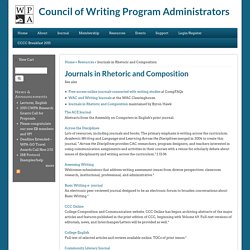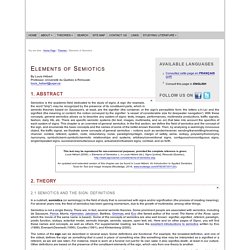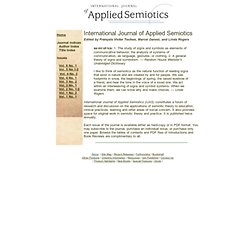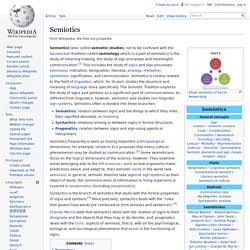

Steven Pinker: Linguistics as a Window to Understanding the Brain. Rhetological Fallacies. Gabriella Coleman - Faculty Bio. Taxonomy of the Logical Fallacies. Home. Council of Writing Program Administrators. See also The ACE Journal Abstracts from the Assembly on Computers in English's print journal.Across the Disciplines Lots of resources, including journals and books.

The primary emphasis is writing across the curriculum. Academic.Writing and Language and Learning Across the Disciplines merged in 2004 to create this journal. " Across the Disciplines provides CAC researchers, program designers, and teachers interested in using communication assignments and activities in their courses with a venue for scholarly debate about issues of disciplinarity and writing across the curriculum. " 2.13.06Assessing Writing Welcomes submissions that address writing assessment issues from diverse perspectives: classroom research, institutional, professional, and administrative.
*Basic Writing e- journal An electronic peer-reviewed journal designed to be an electronic forum to broaden conversations about Basic Writing. *CCC Online College Composition and Communication website. Other Sites of Interest. Writing Spaces Open Textbook Chapters. Introduction to Semiotics / Signo. Follow us on Semiotics is the academic field dedicated to the study of signs.

A sign (for example, the word "ship") may be recognized by the presence of its constituent parts, which in semiotic theories based on Saussure's, at least, are the signifier (the container, or the sign's perceptible form: the letters s-h-i-p) and the signified (the meaning or content; the notion conveyed by the signifier: 'a vessel of considerable size for deepwater navigation'). With these concepts, general semiotics allows us to describe any system of signs: texts, images, performances, multimedia productions, traffic signals, fashion, daily life, etc. There are specific semiotic systems (for text, images, multimedia, and so on) that take into account the specifics of each system of signs.
This chapter is an overview of general semiotics. In a nutshell, semiotics (or semiology) is the field of study that is concerned with signs and/or signification (the process of creating meaning). Conventional Markers. Signo. International Journal of Applied Semiotics. International Journal of Applied Semiotics Edited by François Victor Tochon, Marcel Danesi, and Linda Rogers se·mi·ot·ics: 1.

The study of signs and symbols as elements of communicative behavior; the analysis of systems of communication, as language, gestures, or clothing. 2. A general theory of signs and symbolism. — Random House Webster’s Unabridged Dictionary I like to think of semiotics as the natural function of reading signs that exist in nature and are created by and for people. We see footprints in snow, the beginnings of spring, the raised eyebrow of a friend, and hear the tone in the voice of a loved one. We act within an interweaving of signs and symbol systems.
International Journal of Applied Semiotics (IJAS) constitutes a forum of research and discussion on the applications of semiotic theory to education, clinical practices, learning and other areas of social concern. Each issue of the journal is available either as hard-copy or in PDF format. Semiotics. Semiotics frequently is seen as having important anthropological dimensions; for example, Umberto Eco proposes that every cultural phenomenon may be studied as communication.[2] Some semioticians focus on the logical dimensions of the science, however.

They examine areas belonging also to the life sciences – such as how organisms make predictions about, and adapt to, their semiotic niche in the world (see semiosis). In general, semiotic theories take signs or sign systems as their object of study: the communication of information in living organisms is covered in biosemiotics (including zoosemiotics).
Syntactics is the branch of semiotics that deals with the formal properties of signs and symbols.[3] More precisely, syntactics deals with the "rules that govern how words are combined to form phrases and sentences".[4] Terminology[edit] Ferdinand de Saussure, however, founded his semiotics, which he called semiology, in the social sciences: History[edit] Formulations[edit] Branches[edit] Notes. Applied Semiotics.